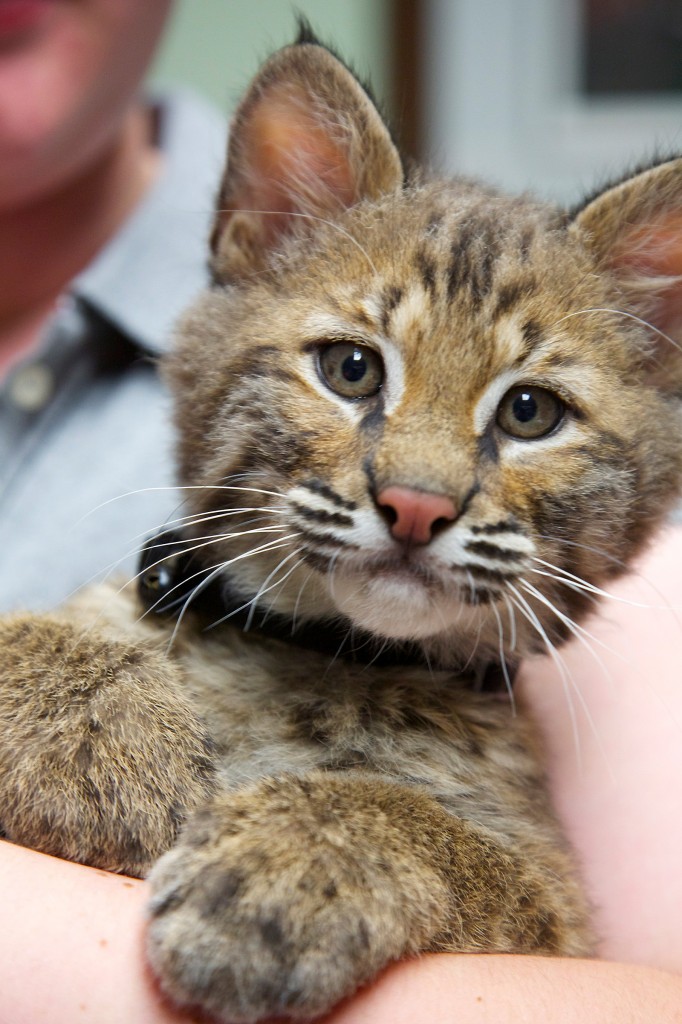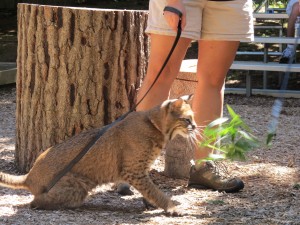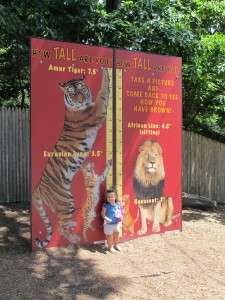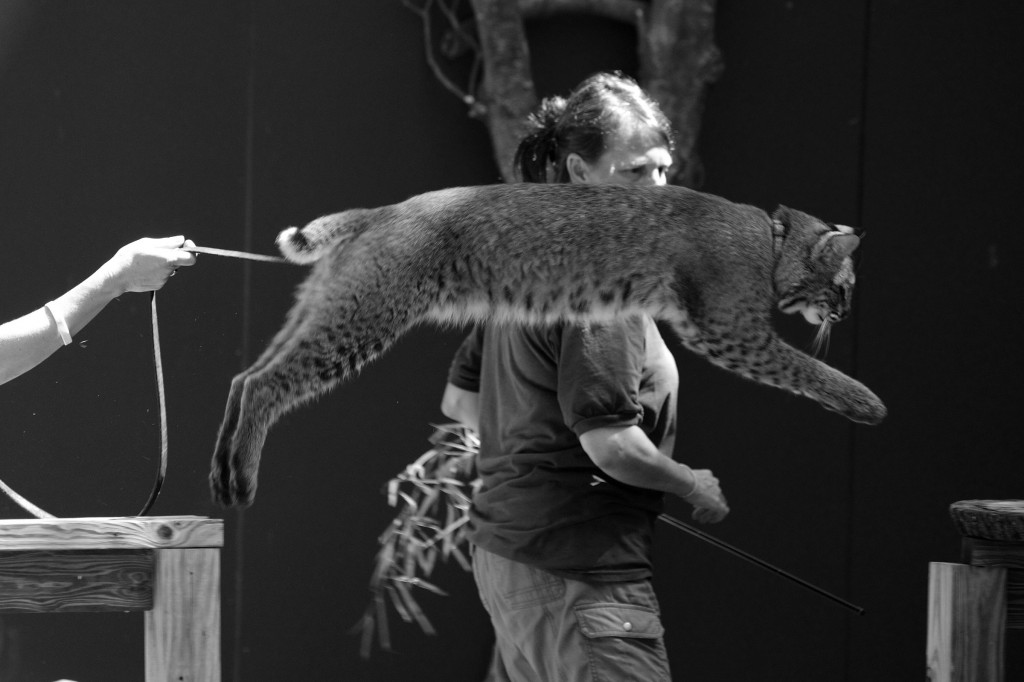
We meet for the first time in October 2012, with a set of metal bars between us. Safe on our opposite sides, we size each other up. BeeZe (rhymes with “easy”) blinks first, blandly, which only goes to show you the stupidity of a staring contest with an opponent who’s indifferent to the game. BeeZe has nothing to prove. BeeZe is a creature of limitless patience. BeeZe has eyes worth a long deep stare: hazel-colored and lamp-like, their expression lying somewhere between complacence and alertness. His gaze flicks between the two people on either side of me. The man to my left presses his face thrillingly close to the cage.
“Hey, big guy,” Gregg Dancho, director of Bridgeport’s Beardsley Zoo, says familiarly. The big guy blinks again. He also shivers, though that may be an illusion caused by the breeze rippling over his striated fur. “Hey, kitty.”
“Aww, are you chilly?” BeeZe’s trainer, Chris Clark, croons. BeeZe does not answer her. With a swish of stubby tail, he streaks from the raised platform to a lower branch, then lands silently on the concrete, lapping water from a silver pet bowl.
This is my first encounter with a bobcat, and the Beardsley staff claims that this bobcat is particularly remarkable. Making polite, appreciative noises, I respond as I often do to acquaintances’ beloved pets, enthusiasm masking bemusement at what seems to me to be a weird and unfathomable love. At six months old and fifteen and a half pounds, BeeZe is roughly the size of an impressive housecat—you can imagine moving him out of the way when you fetch the morning paper, and he seems even tamer with a collar around his neck. But moving BeeZe anywhere takes experience: a quick, sure grab around in just the right place around his shoulder-blades, so that his mittenishly large paws protect you from his bite.
“That’s the physicality we never want the public to see,” Clark confides. If people catch sight of the zoo staff touching BeeZe—whether to correct unruly behavior or to provide comfort—they may get the wrong idea about how they should behave around a wild bobcat.
Right now, relatively few people catch a glimpse of BeeZe. Though he is part of the zoo’s educational program, he is not formally on exhibit. BeeZe has been raised in captivity with the goal of making him an “animal ambassador” for the Beardsley Zoo. While an ambassador’s duties may vary across zoos or species, the Beardsley staff sums them up as “edutainment”: an animal gets trotted out while its keeper explains its habits, habitat, and other key facts to the audience. Some ambassadors move within zoo grounds with a keeper, while others visit schools for educational assemblies. Others may appear at birthday parties or corporate events. Often, the price of the “Animal Encounter” escalates with the glamour of the animal.
The practice of maintaining off-exhibit animal ambassadors is not uncommon, especially among smaller institutions. The only zoo in the state of Connecticut, Beardsley is home to a mere three hundred specimens and seventy-five species, and has a budget of $3.5 million. BeeZe joins a modest diplomatic corps whose mammal members are mostly cute and harmless: a rabbit, a chinchilla, and a ferret. Yet the most significant difference between BeeZe and his colleagues is not size or rank on the food chain, but origin. The majority of Beardsley’s educational animals were acquired from former pet owners or from professional breeders. BeeZe comes from the wild. Now, he makes his home at a zoo that can trace its lineage back to Barnum and Bailey’s Circus, in the 1920s.
He needs to learn, Clark jokes, that he doesn’t want to kill us.
**
In May 2012, a bobcat kitten was found wandering alone by the side of a highway in Connecticut, his mother likely killed by a passing car. The Connecticut Department of Energy and Environmental Protection picked up the orphan, and for lack of a wildlife rehabilitation center in the area, called the Beardsley Zoo. Custody of the three-week-old transferred to Deputy Zoo Director Don Goff and his wife Janet. The Goffs, experienced animal rehabilitators, bottle-fed the kitten for the next seven weeks. He was named BeeZe, after the initials of his new home and employer.
The bobcat (Lynx rufus) has a range that encompasses the continental United States, southern Canada, and parts of Mexico. The Connecticut population is concentrated in the northwest corner of the state. In the last year, there have been sightings in Milford, Winchester, and North Haven. A shy and solitary species, the bobcat is at its most active just after dusk or before dawn, preferring areas dense with young brush. Seeking the spotlight is not in its nature. A wild bobcat would prefer not to interact with humans at all.
A normal kittenhood for BeeZe might have begun in a nest of dried leaves or moss. He would have lived for three to eleven days with his eyes still closed, and nursed alongside his siblings for the next sixty days. At about twenty-eight days old, he might have started to venture out of the rock crevice or hollow log that housed the den. By the time a new year came around, he likely would have left his mother’s territory, making room for the new litter already on the way.
At the zoo, the trajectory of BeeZe’s kittenhood has been extensively planned. The staff maintains a neatly labeled binder of BeeZe’s records dating back to his arrival, including his training schedule, medical information, and handling log, where they note any instance when they’ve made direct physical contact with him since his arrival. The records provide insight into a life of prevailing strangeness. BeeZe is constantly being met with some new experience that no wild bobcat would expect to encounter, like the rumble of a golf cart, the sight of someone in a baseball cap, or the mere, befuddling existence of stairs—an architectural feature for which he has no instinctive physical response. Each encounter initially terrified him.
BeeZe has training once in the morning and once in the late afternoon, sometimes with a third session in between. Three times a day, he’s fed a meal of ground-up horsemeat: breakfast can occur anytime between seven and nine, lunch between twelve and four, and dinner between four and nine. The schedule can’t be too regular, or he’ll become “regimented,” expecting food at an exact time each day and making his performances more difficult to schedule. Mondays are his day off. Having been adequately socialized, BeeZe will help educate visitors—most of them residents of Connecticut—about an animal that they may one day glimpse in their own backyard.
Dancho, the zoo director, is quick to frame BeeZe’s story as an opportunity born out of necessity.
“BeeZe was a special, specific case,” he says. “He was a baby when he was brought here. So, at that point, we could just decide: it could go as a collection animal or it can go into programming. And the staff said, ‘let’s try to do this, and we’ll see what happens.’”
Dancho’s slip between pronouns, though accidental, reflects the uncertainty of BeeZe’s status between self-governing being and object, wild animal and pet. His trainers frequently emphasize his essential wildness, claiming that a bobcat cannot be domesticated—but at the same time, they remain leery of socializing BeeZe too thoroughly.
“If they’re too wild, then an injury could happen to them or to the handler, or to somebody,” says Dancho, “If they’re too much of a pet, then psychologically, they get damaged because they don’t know what they are.”
Sitting together in one of Beardsley’s classrooms, Dancho recounts the classic case of Travis the chimpanzee. Raised as a member of his owners’ household, Travis had acquired a number of uncannily human behaviors, like drinking wine from a stemmed glass. It’s believed that once he hit puberty, over-socialization and testosterone pushed the primate into violence, leading to a much-publicized incident in 2009 when he mauled a friend of the family whom he had known for years. Travis might be an extreme case, given chimpanzees’ intelligence and deep genetic similarities to humans. It may be more difficult to assess psychological damage to a bobcat, and more difficult to inflict it. But the zoo staff remains cautious. Dancho insists, “We want the animal to remain knowing it’s a bobcat. It’s important to do that.” There are strict rules for how visitors conduct themselves with BeeZe: “No cuddling, no hugging, no kissing. No touching with the hands.”
A good animal ambassador doesn’t let relations between his species and humans get too chummy.
**

Teaching a bobcat that he doesn’t want to kill you can be a full-time job. During the most crucial stretch of a kitten’s bonding period, it is imperative that he be exposed to humans even after Beardsley closes each day at 4 p.m. Left behind at the zoo for long and lonely overnights, the bobcat might not become properly socialized. For BeeZe’s first summer and autumn, Chris Clark, his primary caretaker, drove to and from work with a bobcat riding in back. Clark is on the staff of Beardsley’s education department, where she has years of experience working with animals and children, both at the zoo and in the classroom. Because of her background in training dogs for a K-9 unit, Clark was an intuitive choice for the job.
“You have to be a little nuts to try to do this,” she admits. “But it really is the opportunity of a lifetime.”
When she returned home at the end of the day, Clark would let the bobcat loose for a few hours. Unleashing his energy is essential both to BeeZe’s overall happiness and his good behavior. Clark believes that allowing the bobcat to jump on the furniture and generally behave as he likes enables him to work at the zoo with renewed concentration. He can walk on a leash, sit still for photos, and go into his carrier when directed. As the owner of several dogs and cats, Clark runs an exceptionally pet-friendly household: plenty of cardboard boxes to play with, no fragile tchotchkes.
“Luckily enough, my house is an open-floor plan,” she says, “So he can run around like an idiot.”
Sometimes, one of Clark’s German shepherds would wrestle and roughhouse with him. When the dog overpowered BeeZe, she laid her forearms along his body, pinning the bobcat to the ground. When BeeZe overpowered the dog, he jumped on her hindquarters and launched himself to execute a perfect spin in midair; then he went for the throat. Clark has always been able to verbally intervene before anything’s gotten “too crazy,” and BeeZe has never bitten hard. Pairing big cats and domesticated dogs is not an uncommon practice: cheetahs at the San Diego and Houston Zoos have “companion canines” with whom they play. Still, the tussles never fail to impress.
“You realize,” she says matter-of-factly, “How an animal of his size can take down a full-grown deer.”
None of this fazes Clark, who discusses BeeZe with imperturbable humor and affection. While maintaining that, “I can’t get into his little brain,” she is an experienced reader of his body language and moods. She recalls, “When he was a baby, he would get over-tired from play and not realize he would need to take a nap. He would get cranky, like a human child. You would scoop him into his bed for a nappie, and he would get obnoxious.”
Bearing Dancho’s rules in mind, I ask if bobcat kittens like being hugged.
“Well, their moms scoop them into the fold and groom them,” Clark says, “and the worst thing that could happen during a program is he gets scared and he gets loose.” Clark explains that her hug communicates to BeeZe that “I’m the mom, everything’s safe. I will protect you.”
**

A zoo occupies a slippery position on the continuum between domesticity and wildness: it’s a sanctuary with reinforced borders, an intensively managed series of dioramas, a nonprofit organization that must entertain to survive. The modern zoo justifies its existence by measuring its distance from its crueler, more exploitative forebears: the traveling circus, the private menagerie, the drive-thru amusement park.
BeeZe’s home bears an uncomfortably close resemblance to those cheap public entertainments. James W. Beardsley donated one hundred acres of land to Bridgeport in 1878, architect Frederick Law Olmstead drew up designs for the park in 1884, and Parks Commissioner Wesley F. Hayes proposed the zoo in 1920—but the name that looms largest is that of Phineas T. Barnum, the impresario who sold millions of tickets to his circus after he acquired its most famous performer, Jumbo the Elephant. Barnum and Bailey’s animals wintered in the city, and legend has it that the keepers exercised their charges in the streets. Residents would spread picnic blankets on the grounds of Beardsley Park to watch the parade from “The Greatest Show on Earth”: big cats and giraffes, elephants and zebras. The public’s enthrallment to the spectacle purportedly inspired the establishment of the Beardsley Zoo. Barnum contributed a camel to its founding collection, and a number of circus retirees would join the zoo’s ranks over the years.
Beardsley was formally taken over by the city of Bridgeport in the 1920s, and its exhibits and attitudes stayed stuck in that era through the 1980s, when the federal Department of Agriculture found it in violation of new licensing requirements. Animals ranged on concrete, in overcrowded cages. Main roads passed right next to the exhibits. Families entered by driving directly into the zoo, and children would leave their cars, check both ways for oncoming traffic, and run right up to the cages. Beardsley’s layout put the entertainment of the public first, reflecting the outdated assumption that a clean cage and full food bowl represented the extent of an animal’s needs.
“There was no rhyme or reason to the exhibits,” Dancho says, recalling childhood visits to the zoo after church on Sundays. “They were basically random.” He gestures to various buildings along the walkways, where there was once a Mouse House, a petting zoo, and at one point, a Wizard of Oz-themed exhibit. “There was no place to have an educational program, no classrooms.”
Dancho has been employed at the zoo since high school, when he completed in-service training for credit. He eventually became a full-time employee, earned a master’s degree in zoology, and was named the zoo’s director in 1983. Immediately, he sought city, state, and private funding for major renovations. To Dancho, the turning point for the Beardsley Zoo was becoming certified by the Association of Zoos and Aquariums (AZA) in 1987 for meeting its standards for animal care, physical facilities, and guest services. He continually makes reference to the AZA’s core principles of conservation and education—an underst
andable reflex, given that he assumed directorship at a time when some suggested that the zoo simply be shut down altogether. Debate raged in the Hartford Courant: was the Beardsley Zoo a hidden gem, a Noah’s Ark in the most unlikely of cities? Or was it, as
detractors claimed, little more than a postage stamp collection, a peep show of creatures deprived of their dignity?
Bound within Plexiglass walls or chain-link fencing, today’s exhibits cheerily reenact the fractious overlap of human and animal environments. The path to the Wolf Observation Viewing Facility crosses through a replica of a hunter’s cabin, complete with vaguely period lanterns, hay bales, and farm tools. The alligator exhibit boasts a Southern-style wooden porch where the reptiles bask in the sun, right up against the glass and inches away from an old-fashioned rocking chair. Most of the old-fashioned cages are gone, and the spaces are more expansive. But the architecture underscores that, as Head of Education Jim Knox puts it, “Wild is a qualified term.”
**

When I visit in October, the education office smells strongly of cat, and for several uncomfortable hours I suppress sneezes. As a young kitten, BeeZe became something of an office fixture, often allowed free reign while his trainers did paperwork; he quickly settled upon the filing cabinets as a favorite perch. By autumn, the need for constant proximity to his caretakers had abated, and he had grown too active and powerful to stay in that environment for long. His climbing tower and cage still stand next to one desk, and maintenance workers on their way to fix the roof peer around the corner to ask, “No bobcat today?”
“People have a fascination with cats,” explains Knox. He can sympathize: before coming to work at Beardsley, he was a keeper at the Bergen County Zoo in New Jersey, where his favorite animals were the mountain lions.
“I love those guys.” A boyish, dreamy smile spreads across his face. “I just think they’re magnificent.” He blinks, clarifying, “That’s not a scientific term,” then shrugs. “They scare the hell out of me, but I love them. It’s a fascination based on respect.”
For some on the fringes, fascination can give way to an unreserved and reckless infatuation. The Beardsley Zoo often finds itself fielding unsolicited “donations” from the owners of exotic, illegal, or otherwise unmanageable pets: crocodilians, unexpectedly large constrictors, venomous animals, even primates. More often than not, the zoo refuses.
“We don’t want to acquire people’s poor choices,” says Knox.
Most of the visiting public lies on the other end of the spectrum. To them, nature is something that exists elsewhere. Children from surrounding Bridgeport have only experienced animals as threats: rats, cockroaches, tough neighborhood dogs. Even suburban kids, who have more access to summer camp and scouting, don’t get the chance to discover nature in an uninhibited, unstructured way. The Beardsley Zoo is far from unstructured, but Knox sees it as a space where people can begin to forge a more ethical relationship to the wild, learning about native biodiversity, wildlife tolerance, and backyard conservation. In some ways, a local animal like BeeZe makes for the ideal ambassador.
“BeeZe strikes the balance between beautiful and safe,” Knox explains, “He’s not intimidating. He’s intelligent. He works well with people.”
The bobcat also has what Knox calls “charisma,” a term he finds difficult to define in an animal. Environmentalists, however, use the word with varying levels of irony, even dismissal: “charismatic” species, the bald eagles and humpback whales of this world, excite public response disproportionate to their actual ecological importance; at the same time, they can be leverage for those activists wishing to achieve more far-reaching goals. Otherwise, the term is often used as a catch-all, describing animals that are beautiful, affectionate, easily anthropomorphized, or fun to hunt. Inevitably, if unconsciously, the concept of “charisma” is linked to utility for humans.
But when Knox talks about BeeZe’s charisma, he’s not talking about inter-species relationships in the abstract. BeeZe’s charisma is individual and immediate, a function of evaporated distance, the shock of proximity. This is not about glamour shots, or the Discovery Channel. When BeeZe enters a room, he can make it go silent.
**
In October, I sat in on one of BeeZe’s leash training sessions, held in the Learning Center where he would be making most of his presentations. It was one of the most unassuming areas of the zoo: several sets of metal bleachers ringed around a wooden stage backed by drab wooden sets. Someone had discreetly tacked a list of entrances, exits, and cues to the back of one of the walls, a left-over from some previous performance.
This was a two-trainer operation: one had a hold on the cat, and the other had a hold on the bait, a stick-and-string toy ending in a dangling fluffy tail. The secret was harnessing BeeZe’s prey drive, an exercise in empathy, intuition, and split-second anticipation. Expertly and even wittily controlled, the tail twitched just inches beyond his reach; the trainers watched for the twitch of an ear or the ripple of shoulder blades. BeeZe’s body language hinted at what he would do next, so that when he was about to propel forward, the trainer with the leash gave him the verbal command, “Let’s go,” and when he was about to jump, she called, “up.” BeeZe would associate his own actions with his Ultimately, training was not about bending his will to theirs; human guidance had to be congruent with his natural instincts. Throughout, the leash needed to remain at a perfect degree of tautness.
The entire process was incredibly quiet: no calliope music, no crack of the whip, just the sound of New England wind in the leaves, and beyond, the dull roar of traffic. But for even in front of an audience of one, BeeZe was a spectacle. The thrill I felt watching him was primal and strangely voyeuristic.
My return to the Learning Circle in August 2013 brings the sight of a sign advertising for “BeeZe’s Wild Adventure!” and a line of young families and local summer campers waiting to be admitted. As the audience settles into the bleachers, volunteers in pale blue t-shirts circulate, offering a bobcat skull and swatch of fur for them to touch. The performance, ultimately, is a modest affair. Jim Knox takes the microphone and explains the rules to the small crowd: at their distance from the stage there is little danger of touching, but they all need to be quiet so that BeeZe can concentrate.
BeeZe enters, along with Clark and another trainer, Chrissy Shore. Shore has his leash, and Clark a leafy bamboo switch and a handful of treats: shrimp and a zoo feed called Feline Diet. The switch is dangled in front of him like the squirrel’s tail was once, directing his attention to a model waterfall on-stage, or the wooden railing that they want him to balance along, or the ledge on which they want him to leap. As the three of them move behind him, Knox explains bobcat behaviors, elaborating on their preferred habitats, diet, and times of day. When he tells the visitors about how BeeZe came to live at the Beardsley Zoo, he jokes that the bobcat gets free room and board, and free medical and dental plans. The entire presentation lasts only around ten minutes, and after BeeZe exits the stage, Knox takes questions and answers from the crowd. A couple of people comment that they have seen bobcats in their yards, which piques his interest. “Which town?” Knox asks. When they ask what they should do about these sightings, he answers that they should just keep at a safe distance.
BeeZe performs this educational program about three times a week, in addition to his other ambassadorial visits. His schedule since this February has included ten birthday parties, and a corporate event for the Bridgewater Fund. When he hits the one-year mark, the staff will begin advertising encounters with him more widely. He’s even more relaxed, they say, in the zoo’s indoor spaces. Though his trainers had worried about what would happen when he went through puberty at nine months—some animals refuse further training and socialization and must be transitioned to exhibits—the process was much less difficult than they had anticipated.
“Sometimes he was moody with us, but he’s a professional,” Chrissy says. “When he needs to work, he works.”
BeeZe will continue to educate assemblies of students and campers, and to make appearances at birthday parties. He will walk along the rows of kids who have been given strict instructions not to touch. They’ll whisper and shriek, exclaiming over his immaculate fluffiness, his nubby tail. What they are too young to notice, the adult guests might: his perceptive gaze, his impenetrable silence. They will take photos for which he will not pose, not exactly. BeeZe’s attention will move in unreadable ways. He will sit utterly composed, perfectly safe but never quite harmless, collar unable to make us forget those teeth.
Sophia Nguyen is an editor-in-chief of The New Journal.



